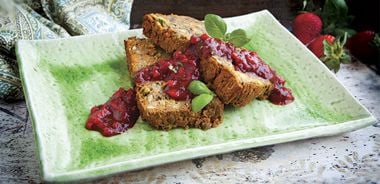Lentil Loaf with Strawberry Sauce

Serves 6
The sweet strawberry sauce is a perfect contrast to the earthy, fully loaded lentil loaf. Leftovers will keep in the refrigerator for up to five days.
Tip: soaking baking paper in water makes it much easier to mould into the shape of the pan.
2 cups (500 ml) dried green lentils, rinsed
1 cup (250 ml) almond flour
160 g can tomato paste
1 cup (250 ml) chopped white button mushrooms
1 cup (250 ml) grated carrot
1 cup (250 ml) frozen or fresh green peas
1/2 cup (125 ml) chopped flat-leaf parsley
2 garlic cloves, finely chopped
2 tsp (10 ml) dried thyme
1 tsp (5 ml) cumin
1/2 tsp (2 ml) sea salt
2 large free-range eggs, lightly beaten
2 tsp (10 ml) grapeseed oil
2 shallots, finely chopped
1 1/2 Tbsp (30 ml) raw style sugar of choice
3 cups (750 ml) strawberries, chopped
1 1/2 Tbsp (30 ml) balsamic vinegar
1/4 tsp (1 ml) freshly ground black pepper
1 1/2 Tbsp (30 ml) chopped fresh basil
Place lentils and 3 cups (750 ml) water in medium-sized saucepan. Bring to a boil, reduce heat and simmer until lentils are tender, about 30 minutes. Drain and rinse lentils. Place 2 cups (500 ml) cooked lentils in food processor container and blend until puréed.
Preheat oven to 350 F (180 C). In large bowl, stir together puréed lentils, remaining cooked whole lentils, almond flour, tomato paste, mushrooms, carrot, peas, parsley, garlic, thyme, cumin, salt and eggs.
Spoon mixture into baking paper-lined 9 x 5 in (23 x 13 cm) loaf pan, making sure to leave some baking paper hanging over edges so you can easily lift the loaf out once cooked. Using spatula, spread out mixture, making sure it’s well packed down. Cook for 45 minutes.
Meanwhile, heat oil in small saucepan over medium heat. Add shallots and sauté until soft, about 3 minutes. Add sugar and continue cooking for 30 seconds. Add strawberries, balsamic vinegar and black pepper; cook 1 minute further. Stir in basil, cover pan and remove from heat.
Cool loaf in pan for 5 minutes. Carefully pull loaf out by lifting sides of baking paper and let cool for another 5 minutes on metal rack.
Serve slices of lentil loaf with strawberry sauce.
Each serving contains: 1972 kilojoules; 26 g protein; 14 g total fat (1 g sat. fat, 0 g trans fat); 65 g total carbohydrates (16 g sugars, 26 g fibre); 298 mg sodium
source: "Little Green Giants", alive Australia #19, Autumn 2014





